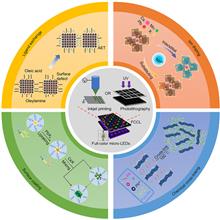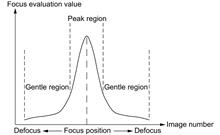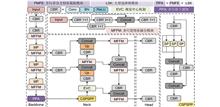 View fulltext
View fulltext
Micro light-emitting diode (Micro-LED) display is considered the "next-generation" ultimate display technology due to its excellent display performance and optoelectronic properties. In order to meet the requirements of near-eye display applications, further miniaturization and integration of Micro-LED are necessary. With the continuous innovation of micro/nanopatterning technology, the fluorescent color conversion layer method has significant advantages such as low manufacturing cost. Compared to the three-color chip method, it is more suitable for virtual/augmented reality display applications that demand higher color gamut and resolution. Perovskite quantum dots (PQDs) are the most promising fluorescent color conversion materials. However, the inherent lattice instability of PQDs and degradation caused by external environmental factors pose significant challenges. Furthermore, it is crucial to develop micro-scale fluorescent array patterns that match the Micro-LED chip array. Therefore, this paper first discusses the factors that affect the structural instability of perovskite quantum dots. Then, it summarizes the applications of strategies such as ligand exchange, ion doping, surface coating, and chemical cross-linking in enhancing the stability of perovskite quantum dots. Finally, the latest research progress for fabricating high-resolution perovskite quantum dot fluorescent arrays using photolithography and inkjet printing techniques is summarized.
In the era of massive data and information, electronic computer processing systems face increasingly greater demands on computing power and energy consumption. Bottlenecks such as the "memory wall" and "power wall" inherent in the traditional von Neumann architecture, coupled with the slowing down or even invalidation of Moore's Law, have posed significant challenges to electronic chips in terms of computing speed and power consumption. Utilizing optical computing as an alternative to traditional electronic computing represents one of the most promising avenues to address current challenges in computing power and power consumption. This review systematically summarized the research progress of optical neural network architectures and algorithms in both on-chip integration and free space, and described typical research efforts in detail. Then, the advantages and disadvantages of these two types of optical neural networks and the training strategies of optical neural networks were discussed and compared. Finally, the potential challenges that optical neural networks may encounter were discussed in depth, and a forward-looking perspective on their future development was offered.
In order to realize the application requirements of ultra-narrowband filters in the field of optical communication and optical sensing, this paper proposes a design concept of introducing a coupled guided mode resonance in an asymmetric grating waveguide structure to complete the efficient transmission filtering for specific wavelengths. The filtering structure consists of two added subwavelength gratings stacked on a silicon-based waveguide with the same period but different filling factors. Light waves are incident vertically from the top of the composite gratings, and the asymmetric resonant coupling of multiple waveguide modes can be excited by adjusting the thickness and filling factor of the bottom grating. Numerical simulations show that extremely strong electric field enhancement can be generated using this symmetry-broken guided-mode resonant coupling. Under the premise of satisfying the high sideband rejection ratio, the structure not only realizes the ultra-narrowband filtering effect of 0.005 nm, but also has a high transmission efficiency of 99%.
Focusing evaluation is the key to extending the depth of field in microscopy with stacked focus. To accurately and quickly obtain the pixel focusing position of the stacked focus image sequences and generate high-quality all-in-focus images, a focusing evaluation algorithm based on color vector space is proposed. This algorithm directly calculates color image gradients in the RGB vector space, fully utilizing the correlation between color channels, avoiding the information loss caused by traditional focus evaluation algorithms when converting color images into grayscale images, and has higher accuracy compared to simple stacking of color component gradients; Using the average Manhattan distance between the center pixel and neighboring pixels in RGB space as the focus evaluation weight can enhance the sensitivity of the focusing part, reduce the evaluation value of the defocused part, and make the focus evaluation curve characteristics tend to be idealized. Seven focusing evaluation algorithms in spatial domain, frequency domain, and statistics were selected for performance comparison experiments with the proposed algorithm. The results indicate that the proposed algorithm has better sensitivity, focusing resolution, and noise resistance in simulated and real microscopic images. The curve characteristics were significantly improved, and its application in microscope depth extension can further improve the quality of stacked focal large-depth imaging.
To address the challenges of complex background interference, multi-scale differences in targets, and the difficulty in extracting small targets from remote sensing images, this paper proposes a remote sensing image detection algorithm based on the YOLOv7-tiny model that integrates the visual center mechanism and parallel patch perception. Firstly, the algorithm introduces an explicit visual center mechanism to establish long-distance dependencies between pixels, enriching the overall semantic information of the image and improving the extraction performance of target textures. Secondly, it improves the parallel patch perception module by adjusting the feature extraction receptive fields to adapt to different target scales. Thirdly, a multi-scale feature fusion module is designed to efficiently fuse multi-layer features, thereby improving the model's inference speed. Experimental results on the RSOD dataset show that the proposed algorithm achieves improvements over YOLOv7-tiny in terms of precision, recall, and mean average precision by 1.5%, 2.4%, and 2.4%, respectively. Additionally, validation on the NWPU VHR-10 and DOTA datasets confirms the strong generalization performance of the proposed algorithm. Comparative analysis with other algorithms further demonstrates the superior performance of the proposed approach.
Based on the characteristics of low light energy loss, relatively simple assembly, relatively easy debugging, and high system resolution, the critical angle focusing technology can be introduced to amplify the extracted focusing signal, improve the detection sensitivity and the smoothness of the focusing curve, and at the same time achieve a larger focal plane detection range, reducing the focusing error affected by the unevenness of the substrate itself. This paper first starts from the basic principle of the differential critical angle focusing technology and obtains the relationship between the defocus amount and the defocus signal through the Fresnel formula and the Newton formula. Secondly, a differential critical angle focusing verification system is built, a four-quadrant photodetector collects the defocus signal of a single critical angle prism, and the defocus signals received by two vertically placed four-quadrant photodetectors are differentially calculated to obtain the relationship between the differential K value and the defocus amount z. The experimental results show that when a wavelength of 532 nm laser and a numerical aperture of 0.3 projection objective are used, the focusing linear range can reach 22 μm. When a numerical aperture of 0.45 projection objective is used, the focusing linear range can reach 14 μm, and the resolution of the differential critical angle focusing method can reach 25 nm.
Optical coherence tomography (OCT) is widely used in ophthalmic diagnosis and adjuvant therapy, but its imaging quality is inevitably affected by speckle noise and motion artifacts. This article proposes a multi teacher knowledge distillation network MK-OCT for OCT super-resolution tasks, which uses teacher networks with different advantages to train balanced, lightweight, and efficient student networks. The use of efficient channel distillation method ECD in MK-OCT also enables the model to better preserve the texture information of retinal images, meeting clinical needs. The experimental results show that compared with classical super-resolution networks, the model proposed in this paper performs well in both reconstruction accuracy and perceptual quality, with smaller model size and less computational complexity.
Most attention mechanisms, while enhancing image features, do not consider the impact of local feature interaction on overall feature representation. To address this issue, this paper proposes a global pooling residual classification network guided by local attention (MSLENet). The baseline network for MSLENet was ResNet34. First, the initial layer structure was modified to retain important image information. Second, a multiple segmentation local enhancement attention mechanism (MSLE) module was introduced. The MSLE module first segmented the image into multiple small images, then enhanced the local features of each small image, and finally integrated these important local features into the global features through feature group interaction. Lastly, a pooling residual (PR) module was proposed to address the information loss problem in the ResNet residual structure and improve the information utilization between layers. The experimental results show that by enhancing the interaction of local features, MSLENet achieves good performance on multiple datasets and effectively improves the expressive ability of the network.
The echelle grating spectrometer has cross-dispersion characteristics, and two-dimensional spectral map reduction is the key link to determine its wavelength measurement accuracy, but the changes of spot coordinates caused by environmental changes, processing and mounting have a serious impact on the accuracy of spectral map reduction. In this paper, a spectrum reduction algorithm based on least-squares image coordinate correction is proposed for the middle-step spectrometer. Firstly, the center-of-mass coordinates of the multi-wavelength spot of the calibrated mercury lamp light source are extracted, and the coefficient matrix is constructed by using the theoretical and actual image point coordinates. The translation, scaling, and rotating coefficients of the two-dimensional image plane are obtained by the least-squares estimation method, and then a polynomial fitting is adopted to reduce the influence of residuals, to achieve the correction of the image coordinates of the spot at different wavelengths, and then achieve the accurate resolution of wavelength, and realize the wavelength accurate solving. The experimental results show that the algorithm can effectively improve the spectral image reduction accuracy of the middle-step spectrometer, and the deviation of the corrected coordinates from the ideal coordinates is less than 0.6 image element under the condition of simulating larger mounting errors, which proves that the algorithm has high accuracy.














